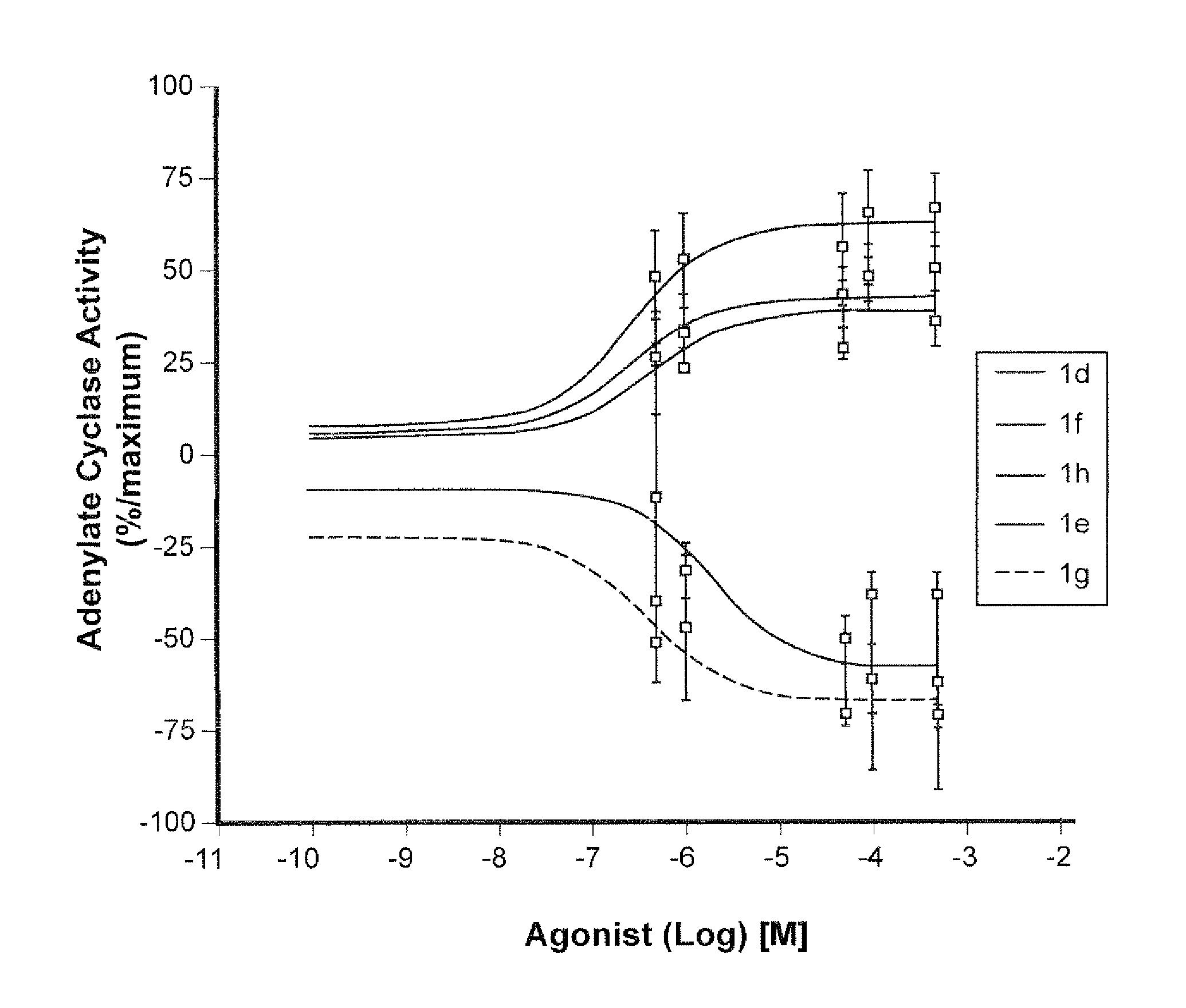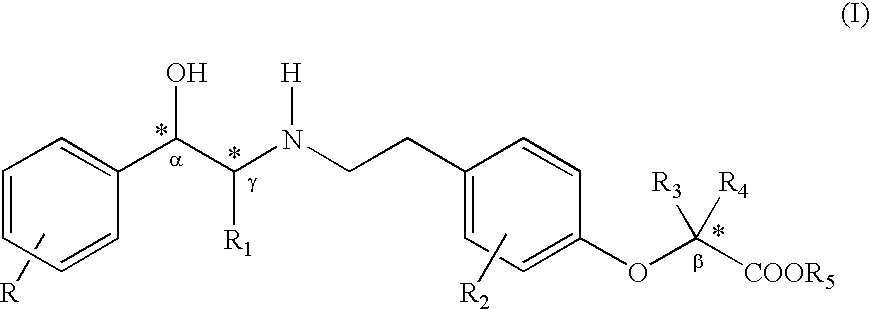Beta-3 receptor ligands and their use in therapy
a beta3 receptor and receptor technology, applied in the field of compounds, can solve problems such as harmful effects on liver metabolism
- Summary
- Abstract
- Description
- Claims
- Application Information
AI Technical Summary
Benefits of technology
Problems solved by technology
Method used
Image
Examples
example 1
Ethyl esters of the (±)-2-[4-[2-(2-phenyl-2-hydroxyethylamino)ethyl]phenoxy]-2-methylpropionic acid (a)
[0111]A compound of 2-[4-(2-bromoethyl)phenoxy]-2-methylpropionic ethyl ester and of racemic 2-amino-1-phenylethanol, in approximately equimolar ratio, in anhydrous N,N-dimethylformamide is maintained in agitation at 70° C. for 70 hours under a nitrogen atmosphere. Ethyl acetate is added to the reaction mixture, the mixture is washed with a saturated NaCl solution and dried on Na2SO4. The solvent is removed under vacuum and the product isolated by column chromatography (silica gel, petroleum ether / ethyl acetate=8:2. Yield=80%. FT-IR (liquid film): 3600-3100, 3060, 3032, 2989, 2935, 2854, 1733, 1611, 1509, 1454, 1383, 1266, 1235, 1179, 1144, 1026, 914, 850, 736, 702 cm−1. 1NMRs (300 MHz, CDCl3, d)): 1.24 (t, J=7.1 Hz, 3H, OCH2CH3), 1.56 (s, 6H, C(CH3)2), 2.70-2.96 (m, 6H, CH2CHOH, CH2NH, CH2CH2NHNH), 3.90-4.10 (bs, 2H, OH and NH: exchanged with D2O), 4.22 (q, J=7.1 Hz, 2H, OCH2 CH3)...
example 2
Ethyl esters of (±)-2-[4-[2-(2-phenyl-2-hydroxyethylamino)ethyl]phenoxy]propionic acid (d)
[0112]A compound of ethyl ester of the 2-[4-(2-bromoethyl)phenoxy]propionic acid and of racemic. 2-amino-1-phenylethanol, in approximately equimolar ratio, in anhydrous N,N-dimethylformamide is maintained in agitation at 70° C. for 70 hours under nitrogen atmosphere. Then the compound is diluted with ethyl acetate, washed with saturated NaCl solution and dried on Na2SO4. The solvent is removed under vacuum and the product isolated by chromatography (silica gel, dichloromethane / ethanol=40:1. Yield=49%. FT-IR (liquid film): 3600-3100, 3058, 3022, 2986, 2935, 2855, 1750, 1669, 1612, 1581, 1511, 1449, 1375, 1292, 1239, 1135, 1050, 1014, 826, 733, 702 cm−1. 1NMRs (300 MHz CDCl3, δ): 1.23 (t, J=7.1 Hz, 3H, OCH2 CH3), 1.58 (d, J=6.8 Hz, 3H, CHCH3), 2.66-3.00 (m, 6H, CH2CHOH, CH2NH, CH2CH2NH), 4.20 (q, J=7.1 Hz, 2H, OCH2 CH3), 4.70 (q, J=6.8 Hz, 2H, CHCH3), 4.86 (dd, J=9.3 and 3.3 Hz, 1H, CHOH), 5.10-5...
examples
(3-8)
[0113]Operating as described in the Examples 1 or 2 but using the appropriate compounds of formula (III) and (IV) the followings compounds are obtained:
Ethyl esters of (−)-2-{4-[2-(R)-2-phenyl-2-hydroxyethylamino)ethyl]phenoxy}-2-methylpropionic acid (b)
PUM
| Property | Measurement | Unit |
|---|---|---|
| temperature | aaaaa | aaaaa |
| pressure | aaaaa | aaaaa |
| pH | aaaaa | aaaaa |
Abstract
Description
Claims
Application Information
 Login to View More
Login to View More - R&D
- Intellectual Property
- Life Sciences
- Materials
- Tech Scout
- Unparalleled Data Quality
- Higher Quality Content
- 60% Fewer Hallucinations
Browse by: Latest US Patents, China's latest patents, Technical Efficacy Thesaurus, Application Domain, Technology Topic, Popular Technical Reports.
© 2025 PatSnap. All rights reserved.Legal|Privacy policy|Modern Slavery Act Transparency Statement|Sitemap|About US| Contact US: help@patsnap.com



